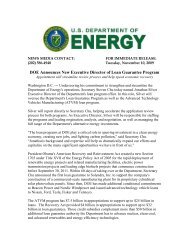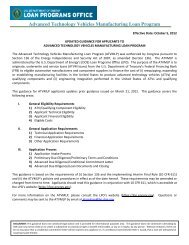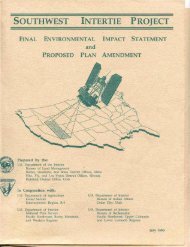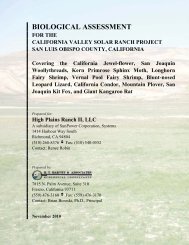Bureau of Land Management's Decision Record and Environmental
Bureau of Land Management's Decision Record and Environmental
Bureau of Land Management's Decision Record and Environmental
You also want an ePaper? Increase the reach of your titles
YUMPU automatically turns print PDFs into web optimized ePapers that Google loves.
Jersey Valley Geothermal Development Project<br />
<strong>Environmental</strong> Assessment: NV063-EAO8-09 1<br />
migrations from higher elevations (summer ranges) to lower winter ranges are associated, in part,<br />
with decreasing temperatures, severe snowstorms, <strong>and</strong> snow depths that reduce mobility <strong>and</strong><br />
food supply. Mule deer in the arid southwest may migrate in response to rainfall patterns<br />
(Stamm 2006).<br />
Mule deer crucial winter, summer or year round habitat has not been identified in the Unit Area<br />
or the transmission line corridor (NDOW 2005b, NDOW 2005c <strong>and</strong> NDOW 2005e). Mule deer<br />
winter habitat was identified in only the easternmost portion <strong>of</strong> the Jersey Valley Unit Area<br />
(NDOW 2005d).<br />
Bighorn sheep<br />
Bighorn sheep inhabit alpine meadows, grassy mountain slopes <strong>and</strong> foothill country near rugged,<br />
rocky cliffs <strong>and</strong> bluffs, allowing for quick escape. In winter, Bighorn sheep prefer slopes 2,500-<br />
5,000 feet where annual snowfall is less than 60 inches a year, because they cannot paw through<br />
deep snow to feed. Their summer range is between 6,000-8,500 feet in elevation (Stamm 2006).<br />
There are no bighorn sheep migration corridors within the Unit Area or the transmission line<br />
corridor (NDOW 2005a). The eastern half <strong>of</strong> the Jersey Valley Unit Area <strong>and</strong> the central <strong>and</strong><br />
northern portions <strong>of</strong> the transmission line corridor have been mapped as bighorn sheep<br />
distribution habitat (NDOW 2005a).<br />
Pronghorn antelope<br />
Pronghorn antelope inhabit the grassl<strong>and</strong>s, brushl<strong>and</strong>s, bunch-grass <strong>and</strong> sagebrush areas <strong>of</strong> open<br />
plains <strong>and</strong> deserts (Stamm 2006).<br />
The westernmost portion <strong>of</strong> the Jersey Valley Unit Area <strong>and</strong> the southern half <strong>of</strong> the transmission<br />
line corridor have been mapped as potential Pronghorn antelope habitat (NDOW 2007). The<br />
northern half <strong>of</strong> the transmission line corridor has been mapped as year-round Pronghorn<br />
antelope habitat (NDOW 2007).<br />
Threatened <strong>and</strong> Endangered Species<br />
Section 7(c) <strong>of</strong> the Endangered Species Act (ESA) <strong>of</strong> 1973, as amended, requires federal<br />
agencies to consult with the U.S. Fish <strong>and</strong> Wildlife Service (USFWS) concerning species listed<br />
under the ESA. Consistent with this requirement, a letter requesting information regarding<br />
threatened <strong>and</strong> endangered species which may occur within the Unit Area <strong>and</strong> the transmission<br />
line corridor was sent to the USFWS on August 11, 2008.<br />
The USFWS responded in a letter dated September 12, 2008 that, to the best <strong>of</strong> their knowledge,<br />
no listed or proposed species exist in the subject area (USFWS 2008).<br />
In February 2008, the Nevada Natural Heritage Program (NNHP) provided a Sensitive Taxa<br />
<strong>Record</strong> Search for endangered, threatened, c<strong>and</strong>idate <strong>and</strong>/or at risk plant <strong>and</strong> animal taxa<br />
- 44 -







